Heraldic Tinctures: Difference between revisions
m →Furs |
m →Proper |
||
| Line 46: | Line 46: | ||
==Proper== | ==Proper== | ||
[[File:Rowena de Segovia Arms2.jpg|100px|left|thumb|Arms of [[Rowena de Segovia]]]] | [[File:Rowena de Segovia Arms2.jpg|100px|left|thumb|Arms of [[Rowena de Segovia]]]] | ||
A charge that is coloured as it naturally appears is blazoned ''proper'' (Fr. ''propre''), or "the colour of nature". An example would be, "an orange tree fructed and eradicated proper," (left). Objects that do not occur in nature may be described as "proper," (such as a dragon or wyvern), and must be described by color. | A charge that is coloured as it naturally appears is blazoned ''proper'' (Fr. ''propre''), or "the colour of nature". An example would be, "an orange tree fructed and eradicated proper," (left). Objects that do not occur in nature may not be described as "proper," (such as a dragon or wyvern), and must be described by color. | ||
[[Category:Articles]] | [[Category:Articles]] | ||
Revision as of 11:47, 24 November 2022
Heraldic Tinctures: Tincture is the limited palette of colors and patterns used in heraldry. They are classified as metals, colours, or furs.
Colours and Metals
The metals are or and argent, representing gold and silver respectively, although in practice they are often depicted as yellow and white. As a general rule of Heraldic Design, do not put Metals on Metals or Colors on Colors (rule of tincture).
Note: The use of hatching is post-period, and was developed by Silvestro de Petra Sancta, in 1638 to facilitate printing in the newly developed printing press. It was sometimes used in the SCA when color Xeroxing was not available.
Stains
Stains (stainand colours or staynard colours): are generally not used in SCA Heraldry. In medieval heraldry, the use of a stain represents a less-than honorable augmentation (abatement or rebatement) imposed by an heraldic authority or by royal decree for misconduct (there is some historical debate on this). These colours include:
- Murrey: Deep mulberry-coloured, or reddish purpl (darker than Purpure).
- Sanguine: Blood-red (darker than Gules)
- Tenné (tawny): orange-tawny colour, though orange is considered distinct in continental European and African heraldic traditions.
Furs
In this earliest period, there were only two furs, ermine and vair. Ermine represents the fur of the stoat, a type of weasel, in its white winter coat, when it is called an ermine. Vair represents the winter coat of the red squirrel, which is blue-grey above and white below. There are examples of other "furs" but these are the most commonly used in SCA Heraldry.
| Vair | Counter-Vair | Potent | Counter-Potent | Ermine | Ermines | Erminois | Pean | Papellone |
|---|---|---|---|---|---|---|---|---|
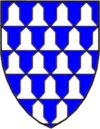 |
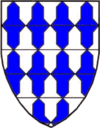 |
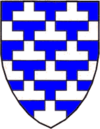 |
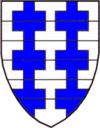 |
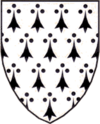 |
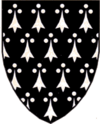 |
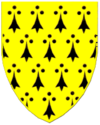 |
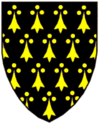 |
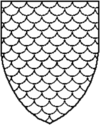
|
| Colours may vary | Colours as Shown | Colours as Shown | Colours as Shown | Colours as Shown | Colours may vary | |||
Proper
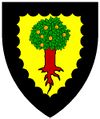
A charge that is coloured as it naturally appears is blazoned proper (Fr. propre), or "the colour of nature". An example would be, "an orange tree fructed and eradicated proper," (left). Objects that do not occur in nature may not be described as "proper," (such as a dragon or wyvern), and must be described by color.












